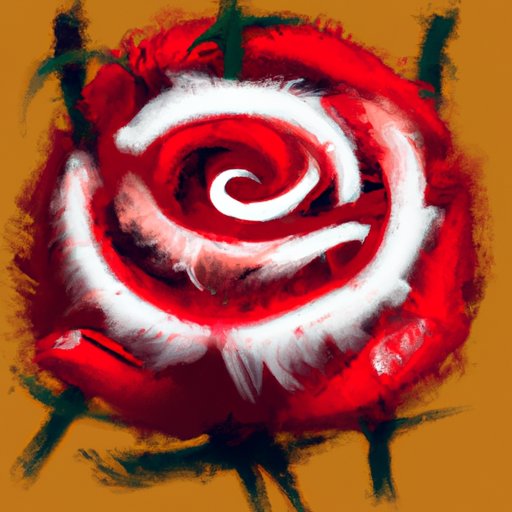
Introduction
Drawing realistic faces can feel like a daunting task, but understanding basic facial proportions, focusing on details and shading, and practicing regularly can improve your skills. This article will provide useful tips and techniques to help you achieve a realistic portrait.
Start with the Basics: Understanding Facial Proportions
Understanding facial proportions is essential to creating a realistic portrait. This includes proportions such as the distance between the eyes, the width of the nose and mouth, and the shape of the face. By keeping these proportions in mind, you can create a more accurate drawing.
One key proportion to keep in mind is the distance between the eyes, which is typically the width of one eye. The nose should be about the same width as the space between the eyes, and the mouth is usually half the width of the nose. The length of the face is typically equal to the distance between the hairline and the eyebrows.
To practice facial proportions, begin with drawing a simple oval shape to serve as the basic head structure. Then, mark off the facial proportions using light pencil lines before adding details. Over time, you can improve your accuracy and find it easier to create realistic faces.
Using a Reference Photo for Accuracy
Working from a reference photo can greatly improve your accuracy. A reference photo can serve as a guide for details such as facial features, shadows, and lighting. Additionally, a reference photo can help you identify and correct any mistakes in your drawing.
When choosing a reference photo, look for a high-quality image with good lighting, contrast, and clarity. Choose a head-on or slightly angled view and avoid any extreme poses or unusual facial expressions. You can also use multiple reference photos to help you understand different angles and perspectives of the face.
When using a reference photo, don’t try to copy it exactly. Instead, use it as a guide to help you create a realistic portrait with your own style and interpretation.
Focusing on the Details: Eyes, Nose, and Lips
Details such as the eyes, nose, and lips can make all the difference in creating a realistic face. Paying attention to these details can help bring your portrait to life.
When drawing the eyes, break them down into basic shapes such as circles or ovals. Pay attention to the size, shape, and placement of the pupils, as well as the thickness and curve of the eyelashes.
When drawing the nose, begin with basic shapes such as triangles or rectangles. Pay attention to the width, length, and shape of the nose, as well as the nostrils and the bridge of the nose.
When drawing the lips, pay attention to the shape and size of the upper and lower lips, as well as the curve and thickness of the mouth. Pay attention to the shadows and highlights around the lips to add dimension.
Tips for Shading and Adding Depth to Your Drawings
Shading and adding depth can help bring your drawing to life by creating shadows and highlights. This can help create the illusion of depth and make your drawing look more realistic.
When shading, start with a light tone and gradually build up the darker tones. Pay attention to the light source in your reference photo and use shading to create shadows on the opposite side of the light source. You can also use shading to emphasize the contours and details of your drawing.
To add depth, use lighter tones for areas that reflect light and darker tones for areas that absorb light. Use a blending tool or your finger to blur the lines between light and dark tones. Don’t be afraid to experiment and play with shadows and highlights to create a unique effect.

Utilizing Different Mediums and Techniques for Unique Effects
There are many different mediums and techniques that you can use to create a unique effect. Experimenting with different mediums and techniques can help you find your own style and create a unique drawing.
Pencil and charcoal are popular mediums for drawing realistic faces. Pencil is ideal for creating precise details, while charcoal is ideal for creating a more dramatic effect. You can also use colored pencils or pastels to add color to your drawing.
Techniques such as cross-hatching and stippling can add texture and depth to your drawing. Cross-hatching involves drawing overlapping lines to create a textured effect, while stippling involves drawing small dots to create a more subtle effect.
Practicing Regularly to Improve Your Skills
Like with anything, regular practice is key to improving your drawing skills. This means creating a regular drawing routine, devoting time to drawing every day, and staying committed to your craft.
One way to overcome creative blocks is to switch up your routine. Experiment with different mediums and techniques, try drawing different subjects, or challenge yourself with new exercises.
Addressing Common Mistakes and How to Avoid Them in Your Drawings
Common mistakes people make while drawing a face include incorrect facial proportions, incorrect shading, and lack of depth. Avoid these mistakes by understanding facial proportions, practicing shading and adding depth, and using a reference photo.
To avoid incorrect facial proportions, use a pencil to measure and mark off the facial features before adding details. To avoid incorrect shading, practice gradually building up darker tones and paying attention to the light source in your reference photo. To avoid lack of depth, pay attention to areas that reflect or absorb light and use shading to add dimension.
Conclusion
To summarize, drawing realistic faces requires an understanding of facial proportions, attention to details such as eyes, nose, and lips, and the use of shading and depth to create a more realistic effect. By practicing regularly, utilizing different mediums and techniques, and staying committed to your craft, you can create stunning portraits that showcase your unique style and talent.





